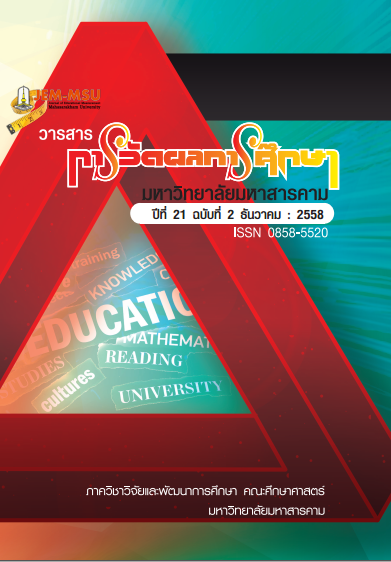The Development of Mathematics Learning Activities Using The Geometer ’s Sketchpad Program (GSP) on Trigonometry Functions for Matthayomsuksa 5 Students.
Main Article Content
Abstract
According to National Education Act 2008, the teaching and learning of
mathematics emphasize to develop every student to have Mathematics learning
activities management attends to develop students’ analytical and synthetical
thinking, and also ability to solve mathematical problems. Teaching mathematics by
using The Geometers’ Sketchpad (GSP) focuses on making students able to discovery
knowledge by themselves and encourages students’ attentions. The geometrical
animation, the application of GSP, helps students to understand difficult content more
easily. The purposes of this research were (1) develop the learning by using The
Geometer’s Sketchpad (GSP) on the topic of Trigonometric Function in Matthayomsuksa 5
with a required efficiency of 75/75 , ( 2) find the effective index value of developing
the instructional activity package supplement to the Geometer’s Sketchpad (GSP)
on the topic of Trigonometric Function in Matthayomsuksa 5, (3) compare mathematical
achievement on Trigonometric Function in Matthayomsuksa 5 between learning by
using the Instructional activity of package supplement to the Geometer’s Sketchpad
(GSP) and using the conventional learning activity, (4) study and investigate the student’s
satisfaction with the instructional activity package supplement to the Geometer’s
Sketchpad (GSP) on the topic of Trigonometric Function in Matthayomsuksa 5.
The sample used in this study was Matthayomsuksa 5 students , 1st
semester, 2012 at Assumption College Ubon Ratchathani located in Muang District in
Ubon Ratchathani province. This consists of the students of two rooms by using
cluster random sampling to test the students in the first group of 39 people and using
control sampling group of 35 people. The whole students were 74 that mixed them
together, then choose one to be experimental group and the one to be controlled
group .The instruments used in this study were nine lesson plans by using the
Geometer’s Sketchpad (GSP) on the topic of Trigonometric Function in Matthayomsuksa 5,
nine conventional lesson plans, multiple choice test of 30 items of mathematical
achievement on the topic of Trigonometric Function in Matthayomsuksa 5; the value
of each item from 0.23 to 0.57 and the reliability of all was 0.89, self-satisfaction form
with the learning by using the Geometer’s Sketchpad (GSP) on the topic of Trigonometric
Function in Matthayomsuksa 5, rating scale of 5 level including 20 items that provided
value of each item (
rxy ) from 0.39 to 0.65 and the reliability of 0.87, and strategy used
to analyze the data such as arithmetic mean, percent, standard deviation and
hypothesis testing with t-test (independent samples). The research results were as follows :
1. The result of the development of learning by using the Geometer’s
Sketchpad (GSP) on the topic of Trigonometric Function in Matthayomsuksa 5 was more
effective than the fixed criteria 79.12/76.84.
2. The effective index value of developing the instructional activity package
supplement to the Geometer’s Sketchpad (GSP) on the topic of Trigonometric Function in
Matthayomsuksa 5 was 0.6140 that showed the percent of learning advance of 61.40
3. Students were taught by using the instructional activity package supplement
to the Geometer’s Sketchpad (GSP) on the topic of Trigonometric Function in Matthayomsuksa 5
were more achievable than the ones who taught by using the conventional learning activity
and the significance of their strategy was .05.
4. Students were taught by using the instructional activity package supplement
to the Geometer’s Sketchpad (GSP) on the topic of Trigonometric Function in Matthayomsuksa 5
were very satisfied with this activity.
Article Details
The content and information contained in the published article in the Journal of Educational Measurement Mahasarakham University represent the opinions and responsibilities of the authors directly. The editorial board of the journal is not necessarily in agreement with or responsible for any of the content.
The articles, data, content, images, etc. that have been published in the Journal of Educational Measurement Mahasarakham University are copyrighted by the journal. If any individual or organization wishes to reproduce or perform any actions involving the entirety or any part of the content, they must obtain written permission from the Journal of Educational Measurement Mahasarakham University.


